Text
The role of ancient people in astrology: what was achieved?
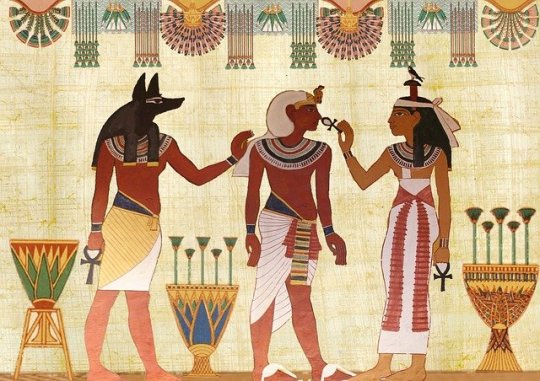
The function of historical humans in astrology: what has been achieved? Astrology may be traced back to the historical Babylonians. They have been the first to attach myths to constellations and outline the zodiac symptoms and symptoms. This machine became delicate with the aid of the Egyptians, after which with the aid of the Greeks. Astrology became additionally practised in different historical cultures. In Greek, the word “Astro” means “star.” Astronomy and astrological understanding have grown collectively in numerous components of the world.
Babylonian and Mesopotamian astrology Babylonian astrology dates from the second century BCE. Mesopotamia recognized five stars similar to the Sun and Moon. They used a technique of prediction referred to as the Enuma Anu Enlil. Earlier kinds of astrology relied heavily on omens. The Babylonian wide variety machine gave an upward push to the minutes and seconds used to degree the zodiac. The historical Babylonians were those who divided the heavens into twelve symptoms and twelve symptoms, or constellations. These twelve divisions have been later named the zodiac with the aid of using the Greeks. The Babylonians used astrology to make vast predictions for the whole nation, which we now call mundane astrology.
Greek Astrology The Greeks made large contributions to astronomy and astrology. The hyperlinks to the Greek gods keep advantaging astrology. When Alexander the Great’s conquests unfolded in Asia, it was widely believed that the Greeks had uncovered the understanding of astrology that existed within the regions that they conquered, including Babylon, Syria, and Persia. They modified the astrology script into Greek.
Hipparchus, a Greek astronomer, developed trigonometry and the equinox precession. Ptolemy, a Greek mathematician, astronomer, and astrologer, wrote the Tetrabiblios. He went into outstanding elements approximately the planets, houses, symptoms, and factors, in addition to their functions. His definitions are nevertheless relevant to trendy Western astrology exercises. Ptolemy additionally defined how the zodiac corresponded to and aligned with the solstices and equinoxes. He additionally explained why planets seem to slow, speed up, and retrograde from Earth’s perspective.
The Roman Empire The Romans made no adjustments to the exercise of astrology. However, their data and documentation have fared better. We have Marcus Manilius’ Astronomica, a poem that covers many aspects of astrology. In Dorotheus of Sidon’s poem on astrology, the idea of triplicities is described.
Egyptian Astrology Astrology was practised extensively in Hellenistic Egypt. We can see depictions of the Zodiac’s twelve symptoms and symptoms in historical Egyptian bas-reliefs. The Egyptians valued the heavenly bodies and believed they had an effect on all humans. They used calendars that displayed beneficial and unfavorable days, much like horoscopes. The pyramids were no longer the most effective of the Pharaohs’ very last resting places, but in addition, they had astronomical significance. Their sloping corridors have been extensively utilized as astronomical sighting tubes.
Mayan Astronomy and Astrology The historical Mayans of Mexico additionally practised astrology. A historical staircase ends in home windows on the Caracol Observatory. Each of those home windows corresponds to the planets’ positions at distinct instances of the year.
Arabian Astrology Many of the Greek ideas of astrology have been followed with the aid of using the Islamic world. There became additionally numerous understanding trade among the Arabs and India. Between the 8th and 10th centuries, there were numerous studies conducted in those fields in Baghdad. Many works have been translated from Greek, Sanskrit, and Pahlavi into Arabic with the aid of their scholars. They then used all of this understanding to fully understand the needs of their religion, Islam, which required them to decide the time and route of Mecca for prayer. As a result, they created calendar gear and techniques in response.
30 notes
·
View notes
Photo



A Spherical Astrolabe, as if the Universe was in your grasp. This palm fitting object, is the only surviving example, made in ca, 1480 AD, a representative model, a working device, which captures it all, heavens included. All the cultures that inherited and developed Greek mathematics and philosophy agreed on the form of the world. The Earth was at the centre of everything, orbited by seven wandering bodies, from the Sun through to Saturn, which shapes our calendar by name. Beyond the orbiting planets were the much more regular fixed stars, imagined as adorning an all-encompassing sphere which spun round once a day. What was beyond the stars? What moved the stars? That was the realm of God, the first or prime mover, ultimately responsible for all heavenly and earthly change. To hold a spherical astrolabe was therefore not just to have a God’s-eye view of the world, but to act as the prime mover in miniature. The instrument’s celestial component is the finely formed ‘rete’ skeletal framework, that surrounds the inner sphere. It carries 19 pointers that represent bright stars in the sky, and so turning the rete round once represents a day. The rete’s largest silver circle is the ecliptic (the path of the Sun over a year). It is divided into the signs of the Zodiac, and the Sun can be located at a fixed point on the ecliptic for any day of the year. Rotating the rete accordingly moves the sun across the sky, enabling the astrolabe to solve many practical problems relating to astronomy and time. In spite of its being signed and dated, little can be said of its origins. Unusually for an Arab the maker signs with a single name, Mūsa (the Arabic equivalent of Moses, and quite a common name). He is known only from this one instrument. The date of A.H. 885 also tells us little. It is over two centuries after the classic treatises on the instrument were written, and rather late in the period to which the style of workmanship belongs. The general style, and in particular the use of Kufic lettering and damascened lettering and decoration, places it in the Syro-Egyptian region, where the centres of craftsmanship were Cairo and Damascus. The silver damascening clearly signals it as a skilfully made, precious object. Source: Museum of the History of Science.
71 notes
·
View notes
Text
Today, I’ll be making a 13th century cheesecake, from Andalucía - the South of Spain! The original text is from a medieval cookbook, by Ibn Razin al-Tujibi, and the audience seems to be for elite members of society. Though today, it’s a simple and easy cake that anyone can make inside an hour!
youtube
In any case, let’s now take a look at The World That Was! Follow along with my YouTube video above!
Ingredients
1 cup flour 1 cup milk 1tbsps yeast (or 1/3 cup sourdough starter) 250g ricotta (or other soft white cheese) honey olive oil cinnamon
Method
1 - Prepare Dough To begin with, we need to make a simple dough. Pour a cup of flour into a bowl, along with a tablespoon of yeast. Dry yeast wouldn’t have been available in antiquity, but wild yeast from a sourdough starter would have been used, and a third of a cup can be used here.
Pour in a cup of room-temperature milk on top of this, along with a splash of olive oil. The original recipe calls for “fat” which can be any one of a huge number of things - like butter, lard, or oils - but olive oil would have also been used. Mix everything together until it takes on a very runny texture. Add a little water if your dough is too dry.
Cover this with a towel and leave it to raise over an hour or so in a warm area.
2 - Assemble Cake
After an hour, go oil up a baking dish. Pour in a ladleful of your dough, and spread it around the base.
On top of this, place a few dollops of ricotta cheese. White cheese is specified here - which again could mean any one of a number of cheeses, but ricotta, or a soft feta, would work well here. Ladle in another layer of dough, before repeating the ricotta process. You can also add some honey between these layers. Though this wasn’t specified, it adds a nice kick of sweetness to the final dish.
Repeat this layering process until you run out of cheese or dough, making sure the top of the cake is covered in a layer of dough.
Place your cake into an oven preheated to 250° C /485° F or as high as your oven will go, and let this bake for a half an hour, rotating it halfway through so it cooks evenly.
3 - Finish Cake
It should be done when the top of it is golden and firm. Pour some honey over the top of this while it’s cooling in the baking dish, and sprinkle some cinnamon over the honey. If you want, you could also use some freshly-ground black pepper which adds a nice warm background to the finished cake.
Leave to cool a bit at room temperature, and serve up!
The finished dish is super light and sweet, and although some of the ricotta didn’t melt completely during the baking process, they have a nice texture when biting into a piece. The cake itself is more like a very light, sweet bread, but is still a really nice and simple dish to make!
91 notes
·
View notes
Text
Algerian Mahjouba 🤤😍😍🤤


Algerian Mahjouba
54 notes
·
View notes
Photo

Today we celebrate the Venerable Theodora of Alexandria. Saint Theodora was a married woman who was tempted into sin with another man, being told that sins done in secret are hidden from God. Falling victim to this deceit, she fornicated with the other man, only to come to her senses soon after and deeply regret her sin. She fled to a male monastery (so that her husband would not find her), presented herself as the monk Theodore and begged the abbot to let her stay. After much persuasion, he allowed her to stay and having confessed her sin, she lived a life of repentance and extreme asceticism, surpassing all the other monks there. One day when sent to get supplies from a nearby village, a woman saw Theodora and fell in love with “him”. Making advances towards the Saint, the woman suggested that they sin together. Rebuking the woman, Theodora continued on her way. In order to take revenge, the woman slept with another and got pregnant, blaming the pregnancy on the “monk Theodore”. When the other monks heard of this, they cast the Saint out of the monastery and the woman abandoned the new born child with Theodora. Living off the pity of nearby farmers, Theodora and the child remained seven years in the wilderness until by divine revelation, the abbot of the monastery was informed that God had forgiven the sin of Theodora. Receiving her back into the monastery, Theodora toiled for some years before reposing in the Lord. Only after her death was it revealed that the monk Theodore was actually a woman, putting all other other monks to shame who judged her for the sin she did not commit. When her husband heard about this, he took up the monastic life and her adopted son went on to become abbot of the monastery. May the Venerable Theodora intercede for us always + #saint #theodora #theodore #alexandria #theodoraofalexandria #egypt #monk #monastic #monastery #sin #repent #repentance #God #ascetic #asceticism #saintoftheday #woman #child #husband #orthodox #saintoftheday (at Alexandria, Egypt) https://www.instagram.com/p/CTpgQKrMWxx/?utm_medium=tumblr
19 notes
·
View notes
Photo

Today we celebrate the Venerable Euphrosyne of Alexandria. When Saint Euphrosyne came of age, her father (the future Saint Paphnutius) wanted her to marry, but she wholeheartedly desired to become a monastic. Secretly fleeing her father’s house, she went to a male monastery dressed as a eunuch called Smaragdus. She chose a male monastery, feeling that her father would find her if she was hidden in a female one. Her father eventually came to this monastery, distraught and asking for consolation for his lost daughter. The abbot recommended he talk to the eunuch Smaragdus (not knowing that this was his actual daughter). Saint Paphnutius poured his heart out on many occasions to the “monk” and only after 38 years in strict asceticism and solitude did the Holy Euphrosyne reveal to her father her true identity. This was on her deathbed, asking that only he prepare her for her body for burial. Having reverently buried his daughter, Saint Paphnutius then distributed his wealth and accepted tonsure, struggling in the very cell his daughter occupied until his eventual martyrdom. May the venerable saints intercede for us always + #saint #saints #euphrosyne #paphnutius #monk #nun #smaragdus #disguise #ascetic #asceticism #alexandria #egypt #orthodox #saintoftheday (at Alexandria, Egypt) https://www.instagram.com/p/CUNeeH7sFFu/?utm_medium=tumblr
20 notes
·
View notes
Photo

Today we also celebrate the Hieromartyr Peter, Archbishop of Alexandria. Saint Peter was born in Alexandria and grew up an educated man. In 300 AD he was elected Archbishop of Alexandria for his piety. Being driven into exile by the Roman Emperor, Saint Peter travelled through many lands, keeping contact with his Alexandrian flock by letter. Having returned to Alexandria, he secretly visited imprisoned Christians as well as helping the widows and orphans of the area, preaching the Word of God. During this time, the infamous heretic, Arius, denied the divinity of Jesus Christ, attempting to tear the Church apart with his heretical teachings. Saint Peter anathematised the heretic and excommunicated him from the Church. The heretic sent two priests to beg the saint for a lift of the ban, pretending that he had repented. The Holy Peter, seeing through the guise of the evil one, instructed his flock not to believe nor come into communion with Arius. Saint Peter once had a vision of the twelve-year-old Christ who appeared to him with a torn cloak. He asked the Lord who had torn his garment and Christ replied, “that madman Arius has torn it by dividing the people whom I have redeemed by My blood. Do not receive him into Communion with the Church, for he has worked evil against Me and My flock.” Throughout his life, Saint Peter never sat on the Bishop’s throne placed in the altar, but rather on a footstool, claiming that every time he approached the throne, a heavenly light would shine on it, and out of reverence, did not dare to sit there. Having led his flock in justice and piety, the Roman Emperor Maximian heard of him, arrested him, and sentenced him to death. The Alexandrian flock were outraged, even to the point of rioting if needed. To avoid any bloodshed, Saint Peter requested that an opening be made from the back of the prison so that he might be taken to execution in secret. At the time of his beheading, a heavenly voice blessed the Saint. May he intercede for us always + #saint #peter #archbishop #alexandria #egypt #bishop #saintpeter #stpeter #petros #hieromartyr #martyr #heresy #preach #preacher #holy #jesus #christ #christian #orthodox (at Alexandria, Egypt) https://www.instagram.com/p/CWoBptOMrI1/?utm_medium=tumblr
15 notes
·
View notes
Text
The Pharos; Giving hope and light for a thousand years
-One of the ancient worlds seven wonders-
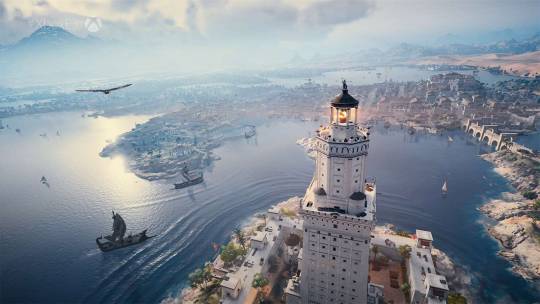
A recreation of the lighthouse of Alexandria
The little Egyptian city of Rhacotis, or Rhakotis in Greek(modern-day Alexandria), already existed in 1900 B.C with its perfect location by the Mediterranean, protected from huge waves and raging sea by the isle of Pharos as well as a pearl band of smaller islands serving as a natural breakwater, giving the harbour safe anchorage conditions. Adding to its advantages, it was fed with sweet waters both from lake Maryut and the Nile river. The city of Rhacotis had long served as a coastal shipping facility and haven supplying the isle of Pharos with goods.
According to Homer, the famous Hellenic writer, the port by the isle of Pharos existed in antiquity. He even described this island in his classic literary work, Odysseus, where Menelaus was stranded on the island of Pharos on his return from the Trojan war.
The old harbour still exists today, but unfortunately at the bottom of the sea on the north side of today’s Ras El-Tin. The city was a centre of civilization, it controlled the commerce between Egypt and the rest of the Mediterranean. Its position was perfect as a vital crossing point for merchants on their maritime routes between Asia and Europe. Egypt was a major producer of grain in the ancient and medieval world likewise cotton was almost as significant.
An unexpected delay and preparation for the future
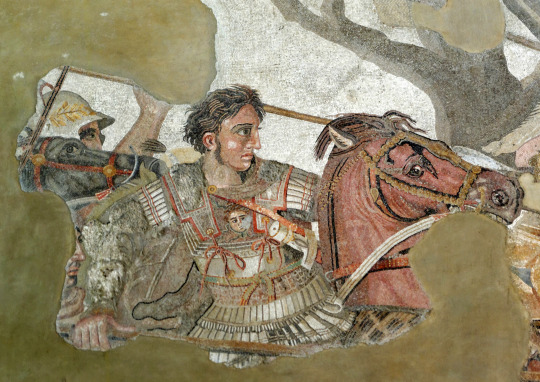
Alexander the great
There is no doubt that the riches associated with the trade, the potential and strategic position of the location and the diversity of ideas and cultures were in the back of Alexander the Great’s mind when in 332 B.C. he attacked the Egyptian coast, just outside of modern-day Alexandria. He arrived there after having conquered the island of Tyre (Known in Latin as Tyrus) but the conquest was unexpectedly delayed.
But to his surprise, the siege was so prolonged, the procedure so difficult, and the resistance so fierce he and his army had to come up with a new strategy. Alexander was in a hurry to conquer the world, but his plans were put on hold for seven whole months as the siege of the island of Tyre lasted from January to August 332 B.C.
As Alexander could not attack the island from the sea, he built a kilometre-long causeway, stretching out to the island on a natural land bridge, no more than two meters deep. After a long preparation and a fierce fight he eventually won the battle and out of anger he burned down the entire island. The similarities between the island of Tyre and the isle of Pharos are striking.
Leaving devastation behind he proceeded to gain control over Egypt. After Alexander’s conquest of Egypt, big plans started to be made for the little city of Rhacotis. The city wasn’t called Rhacotis to begin with, it had another ancient Egyptian name but came to be called Rhacotis by the Greeks.
*Racotis in Greek means; "construction in progress" or "building site".
During the planning and preparation for the expansion and improvements of the already existing city and its harbour, the historical accounts tell us about a peculiar incident.
When Dinocrates, Alexander’s architect, traced the layout of the new city, he didn’t have any chalk at hand so he used barley flour instead. No sooner had he finished than a huge flock of birds appeared, darkening the sky and devouring the flour. At first, Alexander thought it was a bad omen, but his seers convinced him that it was a sign that his new city would provide sustenance for the whole known world.
To assume their position as new rulers of Egypt, Alexander and his men needed a city worthy of their status, a spectacular, contemporary and continental city, a city directed to the sea and such a city needed a spacious and safe harbour. Renewing the already existing port by improving the safety and security of its ships wasn’t enough.
Alexander needed a lighthouse but not any lighthouse would do, he wanted a multipurpose structure, one that could assure safety in the port, and enable the new rulers to have proper surveillance of the city, its harbour, and the country as a whole, in the same time as gaining a building to impress the world!
A safe haven

Satellite view of the port.
The idea of constructing a double harbour was motivated by the fact that there are two principal winds and offshore wave directions. Furthermore, the existence of two separate harbours was advantageous as moving ships from one harbour to another would protect the ships from wave disturbances and keep them safe.
Adding to that there were ships arriving from the Nile as well as others coming from the Mediterranean Sea, spearing them would also avoid confusion in the port.
As a connection between the two harbours, they constructed a so-called “Heptastadion” or mole. It was a giant causeway to link Pharos island to the main coast, giving it a name based on its length. Heptastadion is Greek for seven stadia — Hepta means seven, and a station being a Greek unit of length measuring approximately 180 metres. Altogether, it was more than three-quarters of a mile long.
Ships could now be transferred from the west port of Eunostos to the eastern harbour of Portus Magnus, without going to sea, but through canals cutting through the Heptastadion. On top of that bridges were constructed over the canals.
Now, after the construction was completed, the two harbours were connected by canals and separated by a T-shaped peninsula. Yet, after the constructions were completed they still had a lot to do. The port was deep, making it suitable for ships with big drafts, and the haven was well protected from dangerous northern winds by a string of islands.
Still, without a compass or navigational instruments, it was challenging to find one’s bearings by just observing the coastline as the area around the Nile was an endless landscape of marshes and deserts, the land was so low that it sometimes seemed to be hiding behind the sea. Many sailors found that just when they thought the worst part of their journey was over, their ships would become stranded on a stretch of sand.
A final hurdle was the dabble line of reefs in front of Alexandria, which could prove fatal to sailors and incoming ships. If the winds weren’t favourable, some of these reefs were on the surface while others were submerged, thus presenting even more danger for navigation. Clearly, a lighthouse was necessary, especially after the expansion. But not any lighthouse would do.
The Pharos
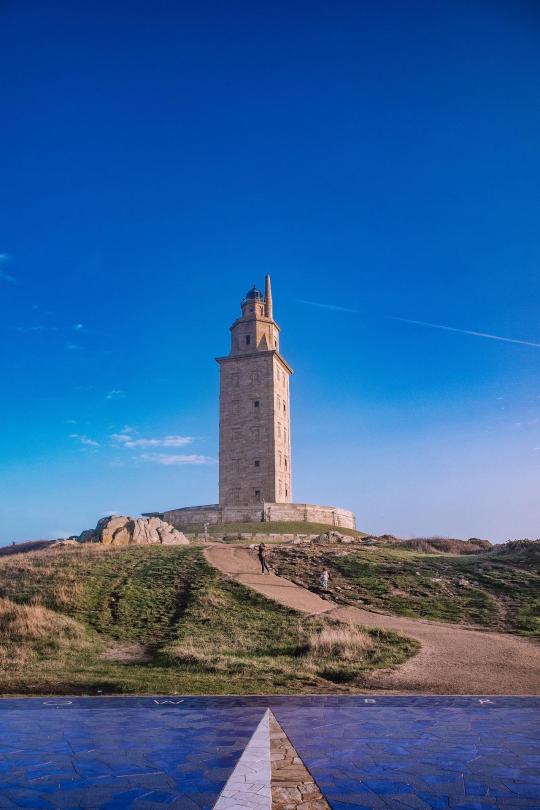
The tower of Hercules, a miniature version of the Alexandria lighthouse in La Coruña, Spain.
With the construction of the new harbour completed, the attention of Alexander’s men shifted to building the lighthouse. It was anticipated to be a colossal structure, solid, sturdy and able to withstand the tests of time as well as the raging of the sea.
During the construction of the massive monument, the cooperation of experienced and competent Egyptian engineers must have contributed greatly. The construction, ordered by Ptolemy I (one of Alexander’s generals and the first ruler of Greek origin in Egypt) began in 290 B.C. and likely took about twenty years.
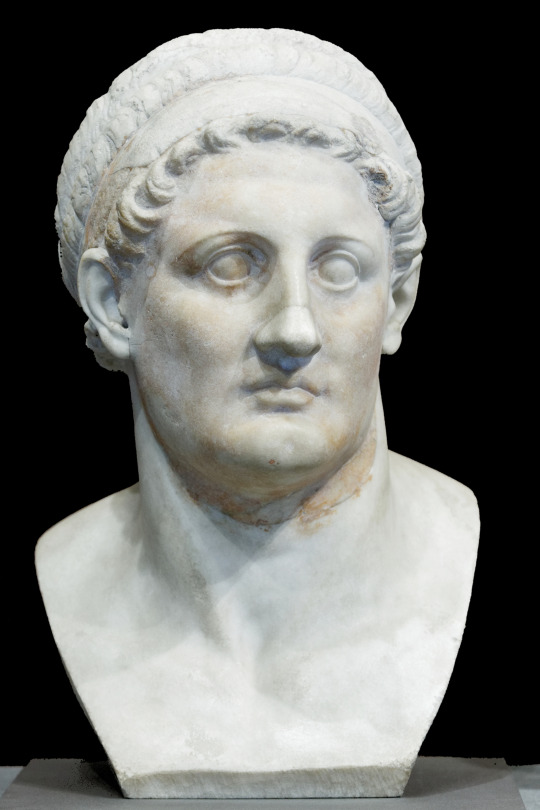
Ptolemy I.
Ancient historical accounts are confusing and contradicting when it comes to describing the lighthouse, but if we were to believe Strabo, a Greek geographer, and Pliny the Elder, a Roman historian, they describe it as—
“Covered with magnificent white marble (or as others say white limestone), and was composed of three basic structures: a rectangular base, an octangular midsection and a cylindrical upper section where two beacons were located”.
Inside the structure, there was a sloping shaft built to lift up fuel needed for the fire at the top. A mirror reflected the sunlight during the day while a fire was used at night. Furthermore, there was a system of 72 ramps with the capability of fitting two horses, one going and one coming, simultaneously, thus the ramp system gave access to the entire lighthouse and all its stories.
For people on foot, there was a whole series of spiral stairs throughout the lighthouse and all its levels, where people could access the entirety of the lighthouse.
The interior itself was massive, it is believed that 364 rooms were built in the Pharos measuring from ten to twenty cubit squares.
*Cubit is an ancient measure of length. It was based on the rough distance between the elbow and the middle finger.
The rooms were designed with vents and windows, in order to absorb gusts of wind against the lighthouse, reducing the risk of collapse. Another function of these rooms was as storage for fuel for the beacon. The rooms were covered by beams of teakwood and decorated with arches of stones.
The viewing galleries were situated on the second and third floors, where visitors could enjoy the beautiful scenery and experience a view from around 400 feet, or 122 meters.
But it was not only the harbour and the sea view that was worth seeing from up there, the water supplying canal and its sewers, and the city’s wide spectacular avenues were a rarity in the eastern Mediterranean at the time. The wondrous city was divided into five districts, but nearly a quarter of its extension was occupied by palaces and royal gardens and their enclosures.
Important visitors had the privilege of being lavishly entertained in some of the rooms allocated for this purpose. The Pharos was fitted with every scientific improvement known at the time.
Finally, at the top of the Pharos, two mirrors were perched; they could reflect the light more than 35 miles (56 kilometres) offshore during daytime, thus making it possible to send mirror signals as a way of communicating with ships at sea. And by night it worked with a lit fire.
Conflicting theories exist on how the mirrors were made, some testimonies assure it was made from a highly polished metal whilst others insist it was made of silver-backed glass or transparent stone. Regardless of what the building material was, the lighthouse dominated the harbour for centuries and the impression it left on the visitor must have been immense.
Ibn Jubayr, a traveller writes —
“Descriptions of it fall short, the eyes fail to comprehend it, and words are inadequate, so vast is the spectacle.”
The abundance of rooms, corridors and connecting spaces inside the Pharos never seemed to stop confusing visitors, it was like a maze, a labyrinth that hindered visitors from finding their way without a guide.
The historian Makrizi makes a stunning statement —
“Whoever entered this lighthouse became distracted and lost their way by reason of the number of chambers and stories and corridors which it contained, so when the Arabs arrived in Alexandria with an army, a body of them entered the Pharos on horseback but lost their way, till they came upon a crevice in the crab of glass*, upon which the structure was founded and many of them fell through it, and perished.”
*During the later pharaonic dynasties a special foundation was used in the shape of a ”glass crab”, it was supposed to support a higher buildings or monuments reinforcing their foundation, stabilizing them and distributing the heavy weight.
Finally, the lighthouse also served as a military lookout for approaching enemy ships or any other danger. It is no coincidence that endless legends and myths surround the great Pharos, which was more than only a pleasure for the eyes, as it served a practical purpose too.
Its shining light safely guided ships for centuries and placed the port city in the centre of Mediterranean trade for a very, very long time. It was one of the seven wonders of the ancient world!
The destruction of the Pharos

The Pharos of Alexandria
Nevertheless, the Pharos didn’t withstand the test of time. In spite of its sturdy construction, it was brutally damaged in the earthquakes of 956, 1303 and 1323 C.E. (A.D.).
By 1408, the Pharos was crippled and collapsed into the coastline. From its ruins still holding foundations, the Egyptian fort of Qaitbay was built on the same site, using the same stones left over from the Pharos.
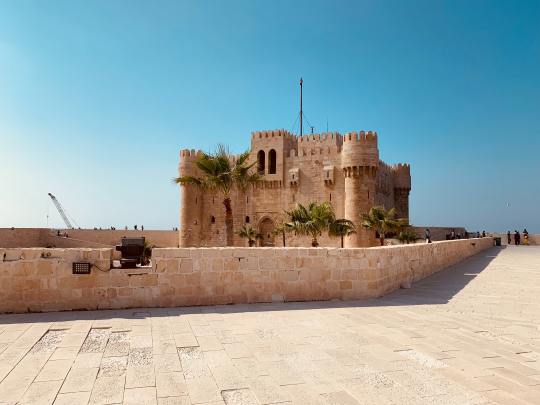
Qaitbay fort.
Even though most opinions are unanimous that it was probably the last three earthquakes that caused the destruction of the lighthouse, one man has another theory.
The 10th-century writer Al-Mas’Ud is convinced the Byzantines sent an ancient spy to the Pharos, they convinced him there was a treasure at the bottom of the lighthouse, and while searching for the treasure, the spy sabotaged its foundation ultimately causing the lighthouse to collapse.
No matter the reason, it continued to prosper long after the Greeks, and even outlived many other rulers and civilizations, then finally, it gave in to forces stronger than itself and fell to ruins. The lighthouse had a major impact on Arab minaret architecture and strongly influenced the way they were built.
It is interesting to note that the Arabic word for minaret and lighthouse is the same: Al Minarah.
But the influence didn’t stop there many other languages lent the word for lighthouse from Pharos. ** see end article.
Even though the Pharos is a much-copied veritable wonder it was not always successful in its mission to safeguard ships, as marine archaeologists have discovered over 40 shipwrecks around the ancient harbour. But on the other hand, who can say how many more disasters there would have been without the lighthouse's safe guidance to port?
Losing a light larger than life
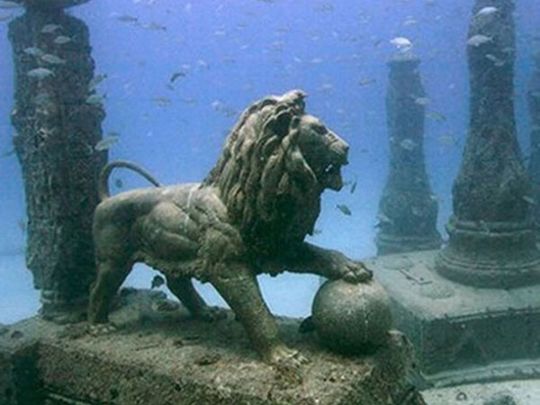
Underwater remains.
Guarding the coast, bathed in blistering sun, and washed by turbulent, salty waters, stood once one of the ancient world’s most impressive structures.
For centuries the Pharos was the sign of ingenuity, raising just a tiny bit short of the great pyramid as another of the seven wonders of the ancient world. Overlooking the Mediterranean’s most turbulent waters it stood for centuries as a saviour for seafarers. It shaped human history. It was the first such building to be constructed and the most famous one.
This indispensable monument of brilliance, the first of its kind in the world, has been a role model for all such buildings, to this day, and for centuries to come.
Rhacotis grew to become Alexandria and later developed further into the Mediterranean bride. But the lighthouse and wonder structure of Pharos that gave us hope and light for centuries, was lost to the sea, forever.
The lost remnants of the lighthouse of Alexandria, the penultimate of the seven wonders of the ancient world, lie underwater near the entrance to the eastern port.
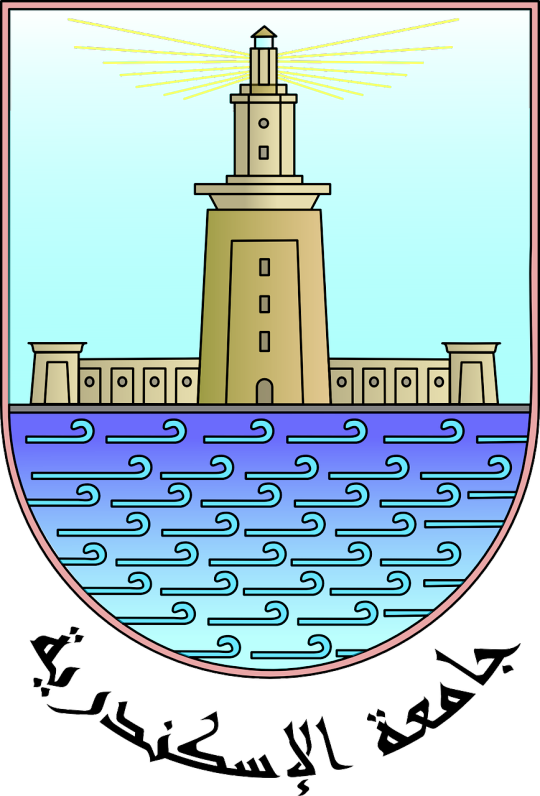
The university of Alexandria using the logo of the Pharo of Alexandria.
**Here are some examples of languages that lent the word Pharos, to showcase the importance of the Pharos. (note that some languages replaced the Greek ph for f).
French: Phare
Greek: Φάρος
Italian: Faro
Norwegian: Fyr (The same word is used in Slavic languages, Bulgarian, Serbian and Russian)
Portuguese: Farol
Romanian: Far
Spanish: Faro
Swedish: Fyr
Turkish: Fener, Feneri
Meanwhile Arabic has its own word
Al-Minarah. Which both means lighthouse and minaret the word derives from the Arabic word Nour: Light
15 notes
·
View notes
Photo

Today we celebrate the Holy Great Martyr Thomaïs of Alexandria. Saint Thomaïs was a married woman who practiced the virtues of patience, love and chastity. One day, when her husband was away on a fishing trip, her father-in-law was filled with impure desires for Thomaïs and approached her, telling her of his intentions. She strongly rebuked him, reminding him of the Last Judgment and how the Great Judge sees all. After much resistance, Saint Thomaïs’ father-in-law drew his sword and slaughtered the innocent woman. He then himself turned blind and went mad. When her husband returned home and saw his bloodied father and slaughtered wife, demanded an explanation. His father confessed all and Saint Thomaïs was buried reverently. She is often invoked during prayer for those battling with carnal temptation. May we all have her blessing + #saint #thomais #great #martyr #greatmartyr #father #fatherinlaw #love #patience #chastity #virtue #prayer #christian #alexandria #egypt #orthodox #saintoftheday #livesofthesaints (at Alexandria, Egypt) https://www.instagram.com/p/CcT1A_yvhp6/?igshid=NGJjMDIxMWI=
21 notes
·
View notes
Photo


2,200 Year Old Alexander the Great Statue Discovered in Alexandria
The Ministry of Antiquities in Cairo has discovered a statue of Alexander the Great within an ancient “residential and commercial zone” in Alexandria that they believe was a trade center in the region during the Ptolemaic period. The archaeologists made their discovery after 9 months of excavations.
The team discovered molds for statues of Alexander the Great at the site as well as an alabaster bust of the iconic ancient leader. Also amongst these items were materials for creating amulets for warriors.
As they explored this area of Alexandria, known as the al-Shatby neighborhoud, “the mission found a large network of tunnel tanks painted in pink for storing rain, flood and groundwater to be used during the draught time” said Mostafa Waziri, the Secretary-General of the Supreme Council of Antiquities of Egypt to the Xinhua news agency.
Waziri further explained the lay out of the town: “it was composed of a main street and several branch roads that are all connected with a sanitation network.”
He believes that the area was active from the 2nd century B.C. to the 4th century A.D. Waziri also noted that the team found an array of pottery pots, coins, plates, fishing tools, and rest houses for travelers. The ruins of the area’s buildings combined with the artifacts found there have led the team to believe that the town had a lively market that sold pots and had workshops for the construction of statues, amulets, and other items.
The fascinating Greek history behind the Egyptian city of Alexandria
The story of Hellenism in Alexandria, Egypt’s second largest city, goes back more than two millennia and is marked by Alexander the Great’s placement of the first stone as part of the city’s first street in 331 BC.
Alexander III, the “Basileus of Macedon”, the “Hegemon of the Hellenic League”, the “Shahanshah” of Persia, the “Pharaoh” of Egypt and the “Lord of Asia” — better known as Alexander the Great — was one of the most significant figures in human history.
Born in Pella, in modern-day Central Macedonia, northern Greece, in 356 B.C., he was the son of Philip II, the King of Macedon and his wife, Olympias. But Alexander was no royal place-holder. He became renowned at a very early age for both for his military and political capabilities.
Hellenistic Alexandria was best known for the Lighthouse of Alexandria (the Pharos), one of the Seven Wonders of the Ancient World; its Great Library (the largest in the ancient world); and its Necropolis, which was one of the Seven Wonders of the Middle Ages.
Alexandria was at one time the second-most powerful city of the ancient Mediterranean region, after Rome.
In modern times, Greeks began to settle in Alexandria again in the 18th and 19th centuries. A new wave of immigration flooded Alexandria shortly after the Greek revolution of 1821, marking the beginning of the so-called European era of the city.
By Thomas Kissel.
114 notes
·
View notes
Photo

Today we celebrate the Venerable Theodora of Alexandria. Saint Theodora was a married woman who was tempted into sin with another man, being told that sins done in secret are hidden from God. Falling victim to this deceit, she fornicated with the other man, only to come to her senses soon after and deeply regret her sin. She fled to a male monastery (so that her husband would not find her), presented herself as the monk Theodore and begged the abbot to let her stay. After much persuasion, he allowed her to stay and having confessed her sin, she lived a life of repentance and extreme asceticism, surpassing all the other monks there. One day when sent to get supplies from a nearby village, a woman saw Theodora and fell in love with “him”. Making advances towards the Saint, the woman suggested that they sin together. Rebuking the woman, Theodora continued on her way. In order to take revenge, the woman slept with another and got pregnant, blaming the pregnancy on the “monk Theodore”. When the other monks heard of this, they cast the Saint out of the monastery and the woman abandoned the new born child with Theodora. Living off the pity of nearby farmers, Theodora and the child remained seven years in the wilderness until by divine revelation, the abbot of the monastery was informed that God had forgiven the sin of Theodora. Receiving her back into the monastery, Theodora toiled for some years before reposing in the Lord. Only after her death was it revealed that the monk Theodore was actually a woman, putting all other other monks to shame who judged her for the sin she did not commit. When her husband heard about this, he took up the monastic life and her adopted son went on to become abbot of the monastery. May the Venerable Theodora intercede for us always + #saint #theodora #theodore #alexandria #theodoraofalexandria #egypt #monk #monastic #monastery #sin #repent #repentance #God #ascetic #asceticism #saintoftheday #woman #child #husband #orthodox #saintoftheday (at Alexandria, Egypt) https://www.instagram.com/p/CiVkpe_LfLy/?igshid=NGJjMDIxMWI=
14 notes
·
View notes
Text
A good example of hellenism in Alexandria

Great example of hellenism. In an old library in Alexandria, that was under the ground that we can see here, were Greek books. Here, we see a typical Greek pillar. Next to it, we see the Egyptian sphinxes, in of course a very Egypyian landscape. Truly fascinating - in of course the most hellenistic city there is, Alexandria, that is literally named in a hellenistic way, after a Greek (Macedon) conquerer.
4 notes
·
View notes
Photo

The Citadel of Qaitbay (قلعة قايتباي) is a 15th-century defensive fortress located on the Mediterranean sea coast, in Alexandria, Egypt. It was established in 1477 AD (882 AH) by Sultan Al-Ashraf Sayf al-Din Qa'it Bay. The Citadel is situated on the eastern side of the northern tip of Pharos Island at the mouth of the Eastern Harbour.
174 notes
·
View notes
Text

The Library of Alexandria, Alexandria, Egypt, 3rd century BCE
The Library of Alexandria is the best-known and largest libraries of the ancient world. It was located in the city of Alexandria in ancient Egypt, which was the major economic, cultural, and intellectual center of the world at the time.
Alexander the Great, who is believed to have founded Alexandria, got the inspiration for his own grand library after visiting the Royal Library of Ashurbanipal. He wanted to collect the works of the people he conquered, convert them to Greek, and store them in a library of his own.
While Alexander the Great did not live long enough to see his dream come true, Ptolemy, who was one of his generals, began constructing the library around the 3rd century. The Library of Alexandria is famous for collecting all of the world’s knowledge at the time, translating the works onto papyrus scrolls, and storing them.
The library flourished until the Roman conquest of Egypt in 30 BCE and it was burned down and thousands of scrolls were lost.
Source: britannica.com
30 notes
·
View notes
Photo
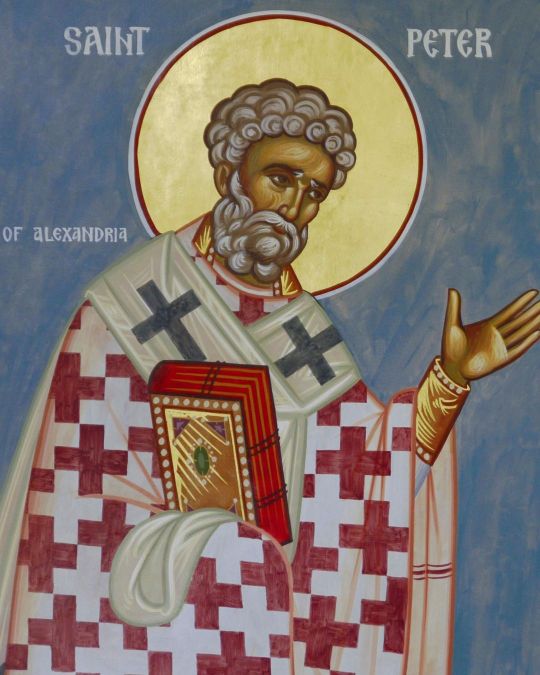
Today we also celebrate the Hieromartyr Peter, Archbishop of Alexandria. Saint Peter was born in Alexandria and grew up an educated man. In 300 AD he was elected Archbishop of Alexandria for his piety. Being driven into exile by the Roman Emperor, Saint Peter travelled through many lands, keeping contact with his Alexandrian flock by letter. Having returned to Alexandria, he secretly visited imprisoned Christians as well as helping the widows and orphans of the area, preaching the Word of God. During this time, the infamous heretic, Arius, denied the divinity of Jesus Christ, attempting to tear the Church apart with his heretical teachings. Saint Peter anathematised the heretic and excommunicated him from the Church. The heretic sent two priests to beg the saint for a lift of the ban, pretending that he had repented. The Holy Peter, seeing through the guise of the evil one, instructed his flock not to believe nor come into communion with Arius. Saint Peter once had a vision of the twelve-year-old Christ who appeared to him with a torn cloak. He asked the Lord who had torn his garment and Christ replied, “that madman Arius has torn it by dividing the people whom I have redeemed by My blood. Do not receive him into Communion with the Church, for he has worked evil against Me and My flock.” Throughout his life, Saint Peter never sat on the Bishop’s throne placed in the altar, but rather on a footstool, claiming that every time he approached the throne, a heavenly light would shine on it, and out of reverence, did not dare to sit there. Having led his flock in justice and piety, the Roman Emperor Maximian heard of him, arrested him, and sentenced him to death. The Alexandrian flock were outraged, even to the point of rioting if needed. To avoid any bloodshed, Saint Peter requested that an opening be made from the back of the prison so that he might be taken to execution in secret. At the time of his beheading, a heavenly voice blessed the Saint. May he intercede for us always + #saint #peter #archbishop #alexandria #egypt #bishop #saintpeter #stpeter #petros #hieromartyr #martyr #heresy #preach #preacher #holy #jesus #christ #christian #orthodox (at Alexandria, Egypt) https://www.instagram.com/p/ClUNkXSLMdi/?igshid=NGJjMDIxMWI=
12 notes
·
View notes
Photo

Saint Cyril of Alexandria Doctor of the Church 376-444 Feast Day: June 27 (New), February 9 (Trad) Patronage: Alexandria, Egypt
Saint Cyril of Alexandria championed the teaching concerning Christ’s one divine Personhood against Nestorius. He wrote extensively clarifying the doctrine concerning the Trinity, theological formulas, and the doctrine of Mary as Mother of God. He had a staunch adherence to the truth, yet, as Bishop of Alexandria, he was impulsive, imprudent, and sometimes harsh dealing with his flock and fellow bishops. He is known as the “Tower of Truth and interpreter of the Word of God made flesh.” {website}
42 notes
·
View notes

